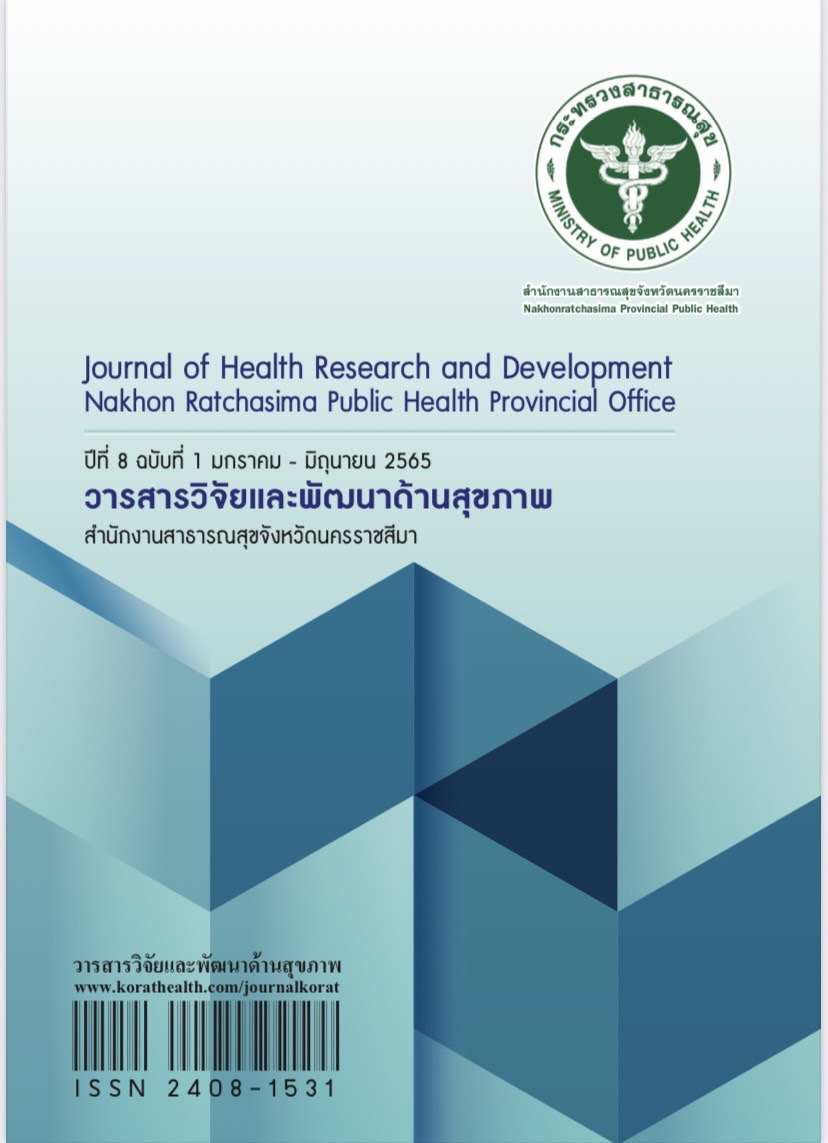ผลกระทบต่อสุขภาพของการสัมผัสไนตรัสออกไซด์ในบุคลากรทางการแพทย์ห้องผ่าตัด กรณีศึกษาโรงยาบาลตติยภูมิ
คำสำคัญ:
ไนตรัสออกไซด์, บุคลากรทางการแพทย์ห้องผ่าตัดบทคัดย่อ
การวิจัยนี้เป็นการศึกษาเชิงวิเคราะห์แบบตัดขวางเพื่อ (1) ค้นหาความสัมพันธ์ระหว่างการสัมผัสไนตรัสออกไซด์และผลกระทบต่อสุขภาพในบุคลากรทางการแพทย์ห้องผ่าตัด (2) ศึกษาความชุกของผลกระทบต่อสุขภาพของการสัมผัสไนตรัสออกไซด์ในบุคลากรทางการแพทย์ห้องผ่าตัด รวบรวมข้อมูลจากการตอบแบบสอบถามคัดกรองอาการทางสุขภาพทั้งหมด 80 คน เป็นบุคลากรทางการแพทย์ห้องผ่าตัด 33 คนและบุคลากรทางการแพทย์ตึกผู้ป่วยใน แผนกอายุรกรรม 47 คน และผลตรวจวัดสิ่งแวดล้อมความเข้มข้นไนตรัสออกไซด์ในห้องผ่าตัด โรงพยาบาลตติยภูมิแห่งหนึ่ง ในจังหวัดนครราชสีมา ช่วงพฤษภาคม พ.ศ. 2564 ถึงพฤษภาคม พ.ศ. 2565
ผลการศึกษา พบว่า ผลกระทบต่อสุขภาพที่พบมากที่สุดในบุคลากรทางการแพทย์ห้องผ่าตัด คือปวดหัว (ร้อยละ 57.6) รองลงมาวิงเวียน (ร้อยละ 27.3) และง่วงซึม (ร้อยละ 33.3) การสัมผัสไนตรัสออกไซด์เป็นปัจจัยเสี่ยงต่อง่วงซึม 4.20 เท่า (Odds Ratio = 4.20; 95% CI; 1.295-13.617) และหัวใจเต้นเร็ว 10.22 เท่า (Odds Ratio = 10.22; 95% CI; 1.168-89.500) การสัมผัสไนตรัสออกไซด์ความเข้มข้น 37.5-50 ppm และสูงเกิน 50 ppm มีโอกาสเกิดวิงเวียน คลื่นไส้อาเจียน ชา ปวดเสียวคล้ายเข็มทิ่ม กล้ามเนื้ออ่อนแรง การตอบสนองช้าลง ความสามารถในการขับรถแย่ลง หัวใจเต้นผิดจังหวะ มีบุตรยากและภาวะแท้งมากกว่าการสัมผัสไนตรัสออกไซด์ความเข้มข้น 5-25 ppm ดังนั้นบุคลากรทางการแพทย์ห้องผ่าตัดควรได้รับการประเมินสุขภาพด้วยแบบสอบถามคัดกรองอาการทางสุขภาพติดตามทุกปี และควบคุมระดับความเข้มข้นไนตรัสออกไซด์ในสถานที่ทำงานไม่ให้เกินค่ามาตรฐานการทำงาน
เอกสารอ้างอิง
กาญจนพิชญ์ กานต์. Nitrous oxide. [ออนไลน์]. (2555). [เข้าถึงเมื่อ วันที่ 21 ตุลาคม 2564]. เข้าถึงได้จาก https://www. summacheeva.org/occtox/nitrous_oxide
กลุ่มศูนย์การแพทย์เฉพาะทางอาชีวเวชศาสตร์และเวชศาสตร์สิ่งแวดล้อม โรงพยาบาลนพรัตนราชธานี. Nitrous oxide (แก๊สหัวเราะ). [ออนไลน์]. (2556). [เข้าถึงเมื่อ วันที่ 21 ตุลาคม 2564]. เข้าถึงได้จาก http://www.occmednop.com/nrhc/web/search/chemical_attribute_show.php?UN_Number=1070&Chemical_name=Nitrous%20oxide%20(แก๊สหัวเราะ)&Att_parent=0
National Institute for Occupational Safety and Health. Nitrous Oxide. [ออนไลน์]. (2561). [เข้าถึงเมื่อ วันที่ 21 ตุลาคม 2564]. เข้าถึงได้จาก https://www.cdc.gov/niosh/ topics / nitrousoxide/default.html
Eftimova B, Sholjakova M, Mirakovski D, et al. Health Effects Associated With Exposure to Anesthetic Gas Nitrous Oxide-N2O in Clinical Hospital – Shtip Personel. Open Access Macedonian Journal of Medical Sciences. 2017;5(6):800 – 4.
Brodsky J, Cohen E, Brown B, et al. Exposure to Nitrous Oxide and Neurologic Disease among Dental Professionals. Anesthesia & Analgesia 1981;60(5): 297 – 301.
Cohen E, Brown B, Wu M, et al. Occupational Disease in Dentistry and Chronic Exposure to Trace Anesthetic Gases. The Journal of the American Dental Association 1980; 101(1): 21 – 31.
Dreyfus E, Tramoni E, Lehucher-Michel M. Persistent cognitive functioning deficits in operating rooms: two cases. International Archives of Occupational and Environmental Health 2008; 82(1): 125 – 30.
Allison RH, Shirley AW, Smith G. Threshold Concentration of Nitrous Oxide Affecting Psychomotor Performance. British Journal of Anaesthesia 1979; 51(3): 177 – 80.
Lucchini R, Placidi D, Toffoletto F, et al. Neurotoxicity in operating room personnel working with gaseous and nongaseous anesthesia. International Archives of Occupational and Environmental Health 1996; 68(3): 188 – 92.
Korttila K, Pfäffli P, Linnoila M, et al. Operating Room Nurses' Psychomotor and Driving Skills after Occupational Exposure to Halothane and Nitrous Oxide. Acta Anaesthesiologica Scandinavica 1978;22(1): 33 – 9.
Weimann J. Toxicity of nitrous oxide. Best Practice & Research Clinical Anaesthesiology 2003;17(1): 47 – 61.
Sweeney B, Bingham R, Amos R, et al. Toxicity of bone marrow in dentists exposed to nitrous oxide. BMJ 1985; 291(6495): 567 – 9.
Krajewski W, Kucharska M, Pilacik B, et al. Impaired vitamin B12 metabolic status in healthcare workers occupationally exposed to nitrous oxide. British Journal of Anaesthesia 2007;99(6): 812 – 8.
Amiri F, Neghab M, Shouroki F, et al. Early, Subclinical Hematological Changes Associated with Occupational Exposure to High Levels of Nitrous Oxide. Toxics. 2018; 6(4): 70.
Peric M, Vranes Z, Marusic M. Immunological disturbances in anaesthetic personnel chronically exposed to high occupational concentrations of nitrous oxide and halothane. Anaesthesia 1991; 46(7): 531 – 7.
Peric M, Vranes Z, Marusic M. Age-dependent haematological disturbances in anaesthetic personnel chronically exposed to high occupational concentrations of halothane and nitrous oxide. Anaesthesia 1994;49(12): 1022 – 7.
Neghab M, Amiri F, Soleimani E, et al. Toxic responses of the liver and kidneys following occupational exposure to anesthetic gases. EXCLI Journal 2020; 19(338): 418 – 29.
Franco G, Marraccini P, Santagostino G, et al. Behaviour of urinary D-glucaric acid excretion in surgical patients and anaesthesiology staff acutely exposed to isoflurane and nitrous oxide. Medicina del Lavoro 1991; 82(6): 527 – 32.
Pietrantonio AM, Barbani F, Anania AV, et al. Urinary measurement of D-glucaric acid in operating room personnel in the Modena USL 16 hospitals. [Online]. (2022). [cited 2021 October 28]. Available from: https://pubmed.ncbi.nlm.nih.gov/1345728/
Olfert S. M. Reproductive outcomes among dental personnel: a review of selected exposures. Journal Canadian Dental Association 2006; 72(9): 821–5.
Rowland A, Baird D, Shore D, et al. Nitrous Oxide and Spontaneous Abortion in Female Dental Assistants. American Journal of Epidemiology 1995; 141(6): 531 – 8.
Rowland A, Baird D, Weinberg C, et al. Reduced Fertility among Women Employed as Dental Assistants Exposed to High Levels of Nitrous Oxide. New England Journal of Medicine 1992; 327(14): 993 – 7.
Cohen E, Brown B, Wu M, et al. Occupational Disease in Dentistry and Chronic Exposure to Trace Anesthetic Gases. The Journal of the American Dental Association 1980; 101(1): 21 – 31.
Bodin L, Axelsson G, Ahlborg G Jr. The association of shift work and nitrous oxide exposure in pregnancy with birth weight and gestational age. Epidemiology 1999; 10(4): 412 – 8.
O’Donovan MR, Hammond TG. Is nitrous oxide a genotoxic carcinogen? Mutagenesis. 2015; 30(4): 459 – 62.
American Conference of Governmental Industrial Hygienists. TLVs and BEIs: Threshold limit values for chemical substances and physical agents and biological exposure indices. Cincinnati: ACGIH; 2021.
National Institute for Occupational Safety and Health. Controlling exposures to nitrous oxide during anesthetic administration. [Online]. (2014). [cited 2021 October 28]. Available from: https://www.cdc.gov /niosh/ docs/94-100/default.html
Occupational Safety and Health Administration. Nitrous oxide. [Online]. (2021). [cited 2021 October 28]. Available from: https://www.osha.gov/chemicaldata/4
กรมสวัสดิการและคุ้มครองแรงงาน. ประกาศกรมสวัสดิการและคุ้มครองแรงงาน เรื่องขีดจำกัดความเข้มข้นของสารเคมีอันตราย พ.ศ.2560. [ออนไลน์]. (2560). [เข้าถึงเมื่อ วันที่ 21 ตุลาคม 2564]. เข้าถึงได้จาก https://ratchakitcha2.soc.go.th/pdfdownload/?id=2115050
Occupational Safety and Health Administration. Anesthetic Gases: guidelines for workplace exposures. [Online]. (2000). [cited 2021 October 28]. Available from: https://www.osha.gov/waste-anesthetic-gases/workplace-exposures-guidelines#C1
สมบัติ ชุติมานุกูล. การศึกษาการสัมผัสแก๊สไนตรัสออกไซด์ของบุคลากรห้องผ่าตัด โรงพยาบาลสามแห่งในจังหวัดระยอง. ระยอง: โรงพยาบาลบ้านฉาง; 2545.
นาตยา พละพลีวัลย์. ระดับ Waste Anesthetic Gas ของห้องผ่าตัด รพ.นครปฐม. วารสารแพทย์เขต 6-7 2549; 25(1): 91 – 5.
Thitiworn Choosong. Assessment of Waste Anesthetic Gases Exposure Among Nurse Anesthetists in a University Hospital. Songklanagarind Medical Journal. 2015; 33(3): 139 – 52.
ดาวน์โหลด
เผยแพร่แล้ว
รูปแบบการอ้างอิง
ฉบับ
ประเภทบทความ
สัญญาอนุญาต
ลิขสิทธิ์ (c) 2022 สำนักงานสาธารณสุขจังหวัดนครราชสีมา

อนุญาตภายใต้เงื่อนไข Creative Commons Attribution-NonCommercial-NoDerivatives 4.0 International License.
บทความที่ได้รับการตีพิมพ์เป็นลิขสิทธิ์ของสำนักงานสาธารณสุขจังหวัดนครราชสีมา กระทรวงสาธารณสุข
ข้อความที่ปรากฏในบทความแต่ละเรื่องในวารสารวิชาการเล่มนี้เป็นความคิดเห็นส่วนตัวของผู้เขียนแต่ละท่านไม่เกี่ยวข้องกับสำนักงานสาธารณสุขจังหวัดนครราชสีมา และบุคลากรท่านอื่นๆในสำนักงานฯ แต่อย่างใด ความรับผิดชอบองค์ประกอบทั้งหมดของบทความแต่ละเรื่องเป็นของผู้เขียนแต่ละท่าน หากมีความผิดพลาดใดๆ ผู้เขียนแต่ละท่านจะรับผิดชอบบทความของตนเองแต่ผู้เดียว



